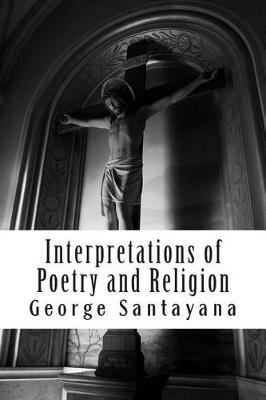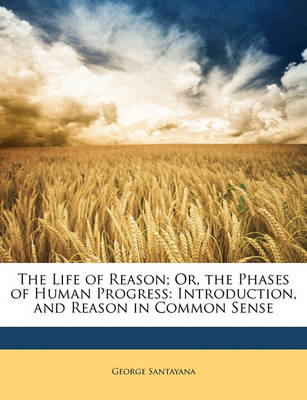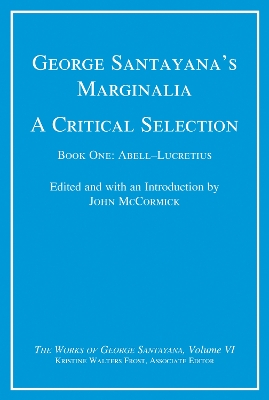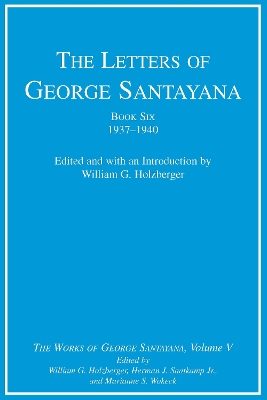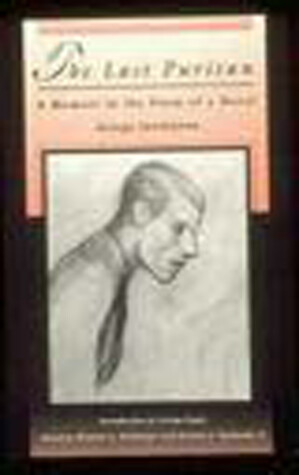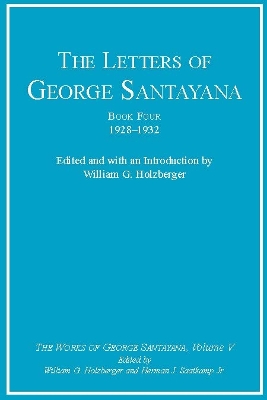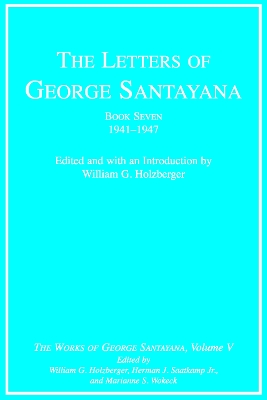The Works of George Santayana
10 total works
Interpretations of Poetry and Religion is the third volume in a new critical edition of the complete works of George Santayana that restores Santayana's original text and provides important new scholarly information.
Published in the spring of 1900, Interpretations of Poetry and Religion was George Santayana's first book of critical prose. It developed his view that "poetry is called religion when it intervenes in life, and religion, when it merely supervenes upon life, is seen to be nothing but poetry." This statement and the point of view it espoused contributed significantly to the debate between science and religion at the turn of the century, and its eloquence and clearsightedness continue to have an impact on current discussions about the nature of religion.
Interpretations of Poetry and Religion affronted Santayana's peers with its assault on literary and religious pieties of the cultivated classes. William James called its philosophy of harmonious and integral ideal systems nothing less than "a perfection of rottenness." In his insightful introductory essay, Joel Porte observes that while Santayana's theory of correlative objects, his espousal of the "ideal"-the normal human affinity for abstraction-and exaltation of the imagination may have offended some at Harvard, these ideas had a significant influence on other Harvard scholars T.S. Eliot and Santayana's "truest disciple," Wallace Stevens.
In this first book of the work, Santayana provides an account of how the human animal develops instinct, passion, and chaotic experience into rationality and ideal life. Inspired by Aristotle's De Anima, Darwin's evolutionary theory, and William James's The Principles of Psychology, Santayana contends that the requirements of action in a hazardous and uncertain environment are the sources of the development of mind. More specifically, instinct and imagination are crucial to the emergence of reason from chaos. Separating himself from the typical thought of the time by his recognition of the imagination, Santayana in this volume offers extensive critiques of various philosophies of mind, including those of Kant and the British empiricists.
This Critical Edition, volume VII of The Works of George Santayana, includes a chronology, notes, bibliography, textual commentary, lists of variants, and other tools useful to Santayana scholars. The other four books of the volume include Reason in Society, Reason in Religion, Reason in Art, and Reason in Science.
The Letters of George Santayana, Book Five, 1933--1936
by George Santayana
A selection of Santayana's notes in the margins of other authors' works that sheds light on his thought, art, and life.
In his essay "Imagination," George Santayana writes, "There are books in which the footnotes, or the comments scrawled by some reader's hand in the margins, may be more interesting than the text." Santayana himself was an inveterate maker of notes in the margins of his books, writing (although neatly, never scrawling) comments that illuminate, contest, or interestingly expand the author's thought. These volumes offer a selection of Santayana's marginalia, transcribed from books in his personal library. These notes give the reader an unusual perspective on Santayana's life and work. He is by turns critical (often), approving (seldom), literary slangy, frivolous, and even spiteful. The notes show his humor, his occasional outcry at a writer's folly, his concern for the niceties of English prose and the placing of Greek accent marks.
These two volumes list alphabetically by author all the books extant that belonged to Santayana, reproducing a selection of his annotations intended to be of use to the reader or student of Santayana's thought, his art, and his life.
Santayana, often living in solitude, spent a great deal of his time talking to, and talking back to, a wonderful miscellany of writers, from Spinoza to Kant to J. S. Mill to Bertrand Russell. These notes document those conversations.
The sixth book of the letters of American philosopher George Santayana, covering the years 1937 to 1940.
The eight books of The Letters of George Santayana bring together over 3,000 letters, many of which have been discovered in the fifty years since Santayana's death. This sixth book covers four years of Santayana's life in Rome, his permanent residence since the late 1920s. During these years, Santayana, in his seventies, saw the publication of the remaining nine volumes of the Triton Edition of his work as well as the last two books of his Realms of Being: The Realm of Truth and The Realm of Spirit. In 1938 the first book-length biography of Santayana was published, and in 1940 The Philosophy of George Santayana-a collection of critical essays that included Santayana's rejoinder, "Apologia pro Mente Sua"-was published as volume two of Northwestern University Press's Library of Living Philosophers. In 1939, when war broke out in Europe and Swiss authorities denied him a long-term visa, Santayana decided to stay in Italy, where he was to remain for the rest of his life. The letters in this book are written to such correspondents as Van Meter Ames, Curt John Ducasse, Max Forrester Eastman, Max Fisch, Sidney Hook, Horace Meyer Kallen, Christopher Janus, Milton Munitz, William Lyon Phelps, and Ezra Pound, and include discussions of the work of Henri Bergson, T. S. Eliot, William Faulkner, and Ezra Pound, among others.
Published in 1935, George Santayana's The Last Puritan was the American philosopher's only novel. It became an instant best-seller, immediately linked in its painful voyage of self discovery to The Education of Henry Adams. It is essentially a novel of ideas, expressed in the birth, life, and early death of Oliver Alden.The Last Puritan is volume four in a new critical edition of The Works of George Santayana that restores Santayana's original text and provides important new scholarly information. Books in this series - the first complete publication of Santayana's works - include an editorial apparatus with notes to the text (identifying persons, places, and ideas), textual commentary (including a description of the composition and publication history, along with a discussion of editorial methods and decisions), discussions of adopted readings, lists of variants and emendations, and line-end hyphenations.
Irving Singer's new introduction to this edition takes up Santayana's philosophical and artistic concerns, including issues of homosexuality raised by the depiction of the novel's two protagonists, Oliver and Mario, and of the relationship between Oliver and the rogue character Jim Darnley. In his thoughtful analysis Singer finds the term "homosexual novel" too reductionist and imprecise for what Santayana is trying to achieve. Singer brings to light the author's skillful and inventive methods for perceiving and interpreting reality, including ideal forms of friendship, and his success in exploring the pervasive moral problems that people face throughout their existence.
The fourth of eight books of the correspondence of George Santayana.
George Santayana published The Realm of Matter (1930) and The Genteel Tradition at Bay (1931). He continued work on Book Three of Realms of Being, The Realm of Truth, and on his novel, The Last Puritan. Citing his commitment to his writing and his intention to retire from academia, he declined offers from Harvard University for the Norton Chair of Poetry and for a position as William James Professor of Philosophy, as well as offers for positions at the New School for Social Research and Brown University. The deaths of his half sisters, Susan Sturgis de Sastre and Josephine Sturgis, in 1928 and 1930, respectively, were extremely distressing to him. Santayana and Charles Strong continued their epistolary debate over the nature and perception of reality and the problem of knowledge. The book also includes letters to Robert Bridges, Cyril Clemens, Morris R. Cohen, Curt John Ducasse, Sydney Hook, Horace Meyer Kallen, Walter Lippmann, Ralph Barton Perry, William Lyon Phelps, and Herbert W. Schneider. Santayana sent many letters with articles and reviews to journalists Wendell T. Bush, Henry Seidel Canby, Wilbur Cross, and John Middleton Murry. Discussion of his novel and continuing work on Realms of Being took place with Otto Kyllmann and John Hall Wheelock, his editors at Constable and Scribner's. Although Santayana now made the Hotel Bristol in Rome his permanent residence, he continued to travel in England, France, and Italy.
The Letters of George Santayana, Book Seven, 1941-1947
by George Santayana
The seventh and penultimate book of the letters of American philosopher George Santayana, covering the years 1941 to 1947 and including letters to such correspondents as Daniel Cory, John Hall Wheelock, Robert Lowell, and others.
This penultimate volume of Santayana's letters chronicles Santayana's life during a difficult time-the war years and the immediate postwar period. The advent of World War II left Santayana isolated in Rome, and the difficulties of wartime travel across borders forced him to abandon plans to move to more agreeable locations in Switzerland or Spain. During these years, Santayana lived in a single room in a nursing home run by the "Blue Sisters" of the Little Company of Mary in Rome, where, during the winter months, he did much of his writing in bed (wearing well-mended gloves) in order to stay warm. And yet, despite wartime deprivations, illness, and old age (he was 77 in 1941), Santayana was remarkably productive, completing both his autobiography Persons and Places and The Idea of Christ in the Gospels: or God in Man, and all but completing Dominations and Powers. He confided to one correspondent that he had "never been more at peace or more happy." The eight books of The Letters of George Santayana bring together over 3,000 letters, many of which have been discovered in the fifty years since Santayana's death. Letters in Book Seven are written to such correspondents as his friend and protegee Daniel Cory, his financial manager and heir George Sturgis, and the American poet Robert Lowell. The correspondence with Lowell-which began when the younger writer sent Santayana a copy of his Pulitzer Prize-winning Lord Weary's Castle-signals an important new friendship, which became a source of affection and intellectual engagement in Santayana's final years.
Three Philosophical Poets: Lucretius, Dante, and Goethe
by George Santayana
Santayana's argument for the unity of philosophy and poetry.
This concise and compelling volume-described by Santayana as a "piece of literary criticism, together with a first broad lesson in the history of philosophy"-introduces Santayana's thought in the rich context of a European poetic tradition that demonstrates his broad conception of philosophy. Rejecting both the Platonic opposition of philosophy and poetry and more recent attempts to reduce philosophy to science, Santayana argues that philosophy and poetry at their best are united in articulating a comprehensive vision of the world that permits honest contemplation of the universe. He considers the ideal visions of three artists: Lucretius's naturalism provides a total perspective on the physical world but renders experience monotonous; Dante's supernaturalism provides a total perspective on experience but subordinates nature to morality; Goethe's romanticism provides a dramatic perspective on nature and experience but lacks totality. Santayana sees each as the best in his own way, though none is best in all ways; and he speculates that the ideal poet would integrate the gifts and insights of all three, resulting in "rational art," of which philosophical poetry is a prime example.
This critical edition, volume VIII of The Works of George Santayana, includes notes, textual commentary, lists of variants and emendations, an index, and other tools useful to Santayana scholars.
